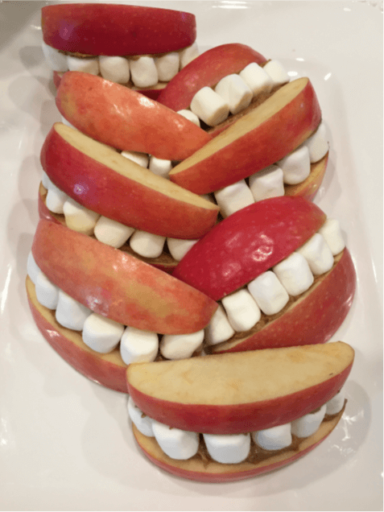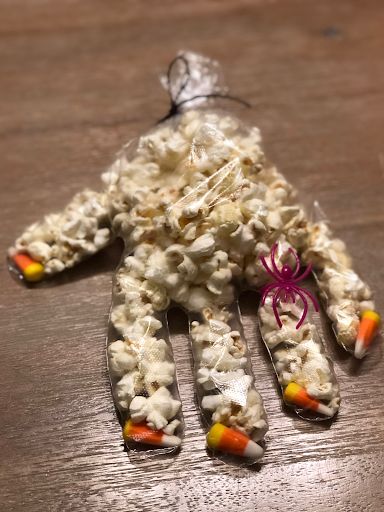What’s So Scary About Halloween?
There’s just something about mid-October. The first hint of cooler weather that blows in on a breeze, the excitement of baseball playoffs while football season finds its groove, the comfort of a daily routine after all of the hustle and bustle of back to school. And oh, the pumpkins! Pumpkins in the grocery store, pumpkin patches, pumpkin lattes, pumpkin-scented candles, and even pumpkin waffles. Yes please!
Pumpkins are popping up on our neighbors’ porches, too. Some homes in our neighborhood now decorate for Halloween as much as they do for Christmas. I’m more of a decorate-just-for-Halloween-night kind of gal, but my kids love all of the fanfare. They watch Curious George’s “Boo Fest” on repeat this time of year, and they’ve been dreaming up their Halloween costumes for over a month.
Gillian (11) decided fairly early this year, upon seeing a costume at Target, that she would be a hot dog. (I told her she could say she’s a Hallo-weenie.) Isaac (14) is going as a polar bear. Clearly we don’t have one of those perfectly planned, family-themed costumes this year, but a hot dog and a polar bear have more in common at our house than first meets the eye. Our dog, Murphy, has a hot dog costume we bought for his first Halloween, because I thought it was so funny. And Isaac always calls Murphy “Polar Bear,” because he kinda looks like one with his fluffy white fur. So maybe both kids are just dressing up like our dog.
For his part, my husband, Todd, will probably be Ted Lasso (or “Todd Lasso”) again, and I’m debating whether or not to make a return appearance as his boss, Rebekah. But I digress.
Halloween is a great time to feel like a kid again and have fun together as a family. But for all of the fun Halloween promises, it also creates some serious anxiety for kids with disabilities and their parents. (Did you know that October is Learning Disabilities Awareness Month? Neither did I, which is why we need awareness!)
Halloween Disabilities Awareness
As the parent of a child with an XY chromosome variation, I can attest that Halloween’s ghosts, ghouls, and goblins don’t scare me a bit. What does get me spooked are the made-for-a-horror-movie screams that come from my child when he is dysregulated, which is all the more likely to happen on an occasion like Halloween. If you are caring for a child with disabilities or just want to be sensitive to sensitive kids, here are some tips to keep in mind as you head into the holiday.
Candy
The sheer amount of candy kids are given at Halloween is an area of concern for many parents and doubly so for those of us whose kids have sensitivities to sugar, food dye, gluten, and other additives. This is a tricky balance for me to navigate as a parent, because my kids are as excited about the candy as I am about the pumpkins. And I know I’m not alone.
My advice: Set expectations ahead of time and stick to them. If there are certain treats your child cannot have, even in small quantities, be clear about what you will do if she gets them in her haul, and provide a trade-off, if necessary. We typically allow just a few pieces (3-5 small ones) of candy on Halloween night and collect the rest to give sparingly (1-2 per day) for the next few days. After about a week, we keep only the premium candies to give as occasional treats and donate the rest.
When Isaac was really young and had extreme dietary restrictions, I went around to the neighbors on our cul-de-sac ahead of time and gave them little items to put in his pail, like Halloween-themed toothbrushes and toothpaste, socks, etc. Many of them followed suit and put together special gifts for him and his sister in subsequent years. The Teal Pumpkin Project offers a great way to do this on a larger scale, so that families can find homes nearby that offer non-candy items for kids, like glowing necklaces, vampire teeth, themed pencils, and the like.
If you want to keep it festive and make sure your kids are properly spoiled but curb the excess of sugary treats, scan Pinterest for creative ideas. Some of my favorites are apple lips with marshmallow teeth and popcorn-filled gloves with candy-corn fingernails, which even amateurs can do. (Photos are mine!) You can also get a bat- or ghost-shaped tin and bake gluten-free/dairy-free or low-sugar brownies.


Costumes
The sensory stimulation of wearing a costume and seeing others in costume is another potential obstacle and source of anxiety. When Isaac was two years old, he was the cutest lion you’ve ever seen with his little costume and big mane. But it was 80+ degrees out on Halloween night that year, and he was burning up, poor thing. We’re hoping for cooler weather this time around with the polar bear suit, but I know better now than to just hope. Some kiddos can power through that kind of thing, but for others like my Isaac, it can completely unravel their self-regulation and ruin a fun family evening.
My advice: Plan ahead to anticipate potential problems and preview your child about your plan for Halloween night and/or Halloween parties. Be realistic about your child’s timeline and ability. A few days before Halloween, set aside some time for yourself (maybe over a pumpkin latte!) to envision the evening—from getting dressed in costumes, to where and how long you will go trick-or-treating, to what your exit strategy will be if there’s a problem. Walk your child through the plan so he is not surprised by the parameters you’ve put in place. If necessary, practice putting the costume on and taking it off, and make a back-up plan for what to do if he becomes uncomfortable while wearing it. It can be as simple as writing “HUMAN” on a name tag or necklace and calling it a night.
Stranger Danger
Stranger danger is an important lesson to teach our kids, and it takes on some new dimensions at Halloween. We tell kids all the time not to take candy from strangers, but on Halloween, we send them out to do that very thing. We shouldn’t take it for granted that they understand what’s different. We need to break it down.
My advice: Explain the tradition of going door to door in a safe/known neighborhood on this one special night. Geek out and give them the history of the holiday (in small doses) if you think they will enjoy it. Most importantly, teach them the importance of staying with a group, whether family for the younger set or a small friend group for older kids. Tell them not to go along with anyone who tries to lure them away by themselves, even if they are offering candy. Be intentional. Make sure they know the costumes of everyone in their group before they leave your home. And finally, make sure there is one responsible person who is always looking out for your more vulnerable child. Don’t assume; assign.
Yes, it’s great to go out on Halloween night to have fun and maybe even play a trick or two. But do plan ahead to save your kiddo(s) from the really scary stuff.
What About You?
So there you have it…a summary of all my Halloween anxieties and their antidotes! I hope they help you to plan for a fun and safe Halloween with your family. I’d love to hear some of your tips and strategies for navigating the challenges of Halloween and other holidays in the comments. Enjoy the cool breeze and pumpkin everything before the winter holiday season sneaks up on you. Boo!
Ann Bell Worley is a writer, presenter, and mother of two children, one of whom has a rare XY chromosome difference as well as an elusive neuroimmune disorder. She is the author of two children’s storybooks based on Nurtured Heart Approach (NHA) and the creator of www.graycoloredglasses.blog, which focuses on the challenges of parenting a medically complex child.
CONTACT
Our Foundation specializes in X & Y Chromosomal Variation Disorders such as Klinefelters 47, Testosterone, Dyslexia, Dyspraxia, ADHD, and other Genetic Disorders. For more information please contact us or schedule a consultation at: thefocusfoundation.org/contact-us
If you have a child who has recently been diagnosed with an X and Y Chromosomal Variation and you need more information, contact The Focus Foundation:
dexy@thefocusfoundation.org
443-223-7323
www.thefocusfoundation.org







